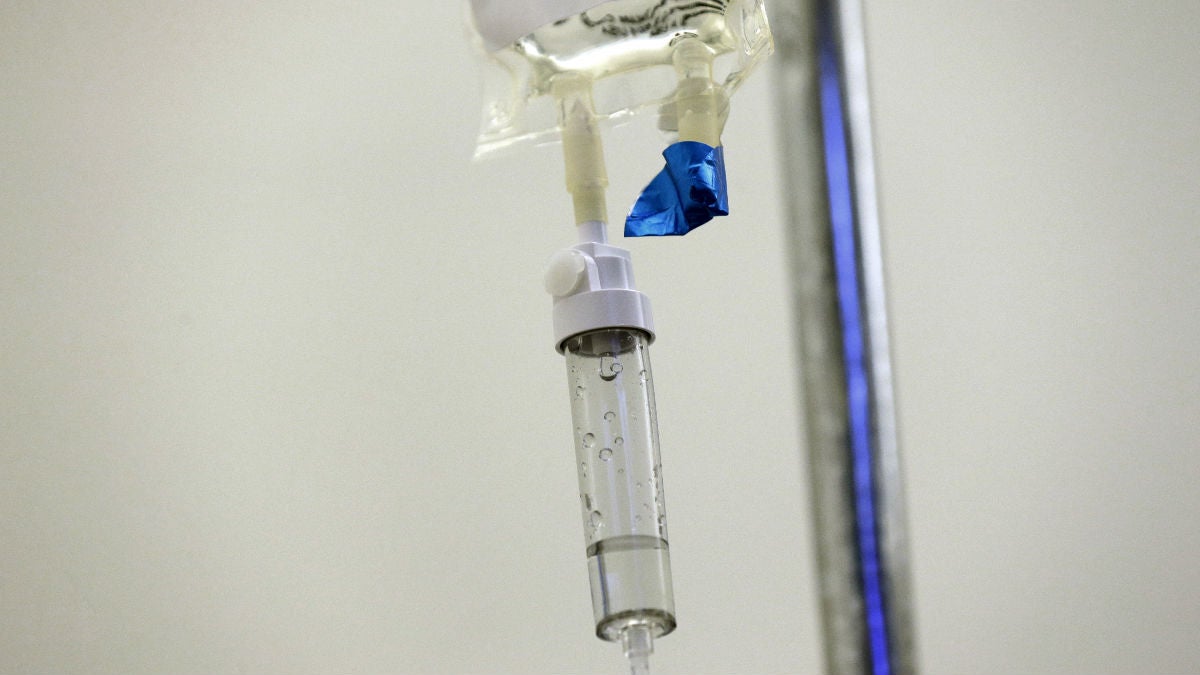Delaware cancer death rate drops, but still higher than nation

Chemotherapy drugs are administered to a patient. (AP Photo/Gerry Broome)
The number of deaths due to cancer in Delaware has dropped over the past decade, but the state still has work to do.
Delaware Division of Public Health officials credited cancer screening and early detection for the decline in deaths from all types of cancer. DPH presented its annual report with the latest cancer data to the Delaware Cancer Consortium today.
According to the Cancer Incidence and Mortality in Delaware, 2009-2013 report, Delaware ranks 16th among the states for the highest number of cancer deaths. That’s two spots lower than its ranking of 14th in last year’s report, which looked at the 2008-2012 time period.
The numbers showed Delaware’s cancer mortality rate fell 18 percent among men, 14 percent among women, 24 percent among African Americans, and 13 percent among Caucasians over the last decade.
However, the state’s mortality rate was still 5 percent higher than the national rate for 2009-2013. Delaware saw 176.1 deaths per 100,000 people; the U.S. rate was 168.5 within that timeframe.
The progress is considerable, though, if you compare it to the 1990s, when the state had the second highest mortality rate in the nation.
Regarding incidence, diagnoses for cancer in Delaware was 13 percent higher than the comparable national rate from 2009-2013 with 507.3 diagnoses per 100,000. But comparing that data to the timeframe 10 years prior, the incidence rate of cancer fell 1 percent, falling 4 percent among men but increasing by 2 percent in women. The cancer incidence rate decreased by 9 percent among African Americans, but increased by 1 percent among Caucasians.
“Delaware is making great progress in battling the deadly disease of cancer in our state” said Governor John Carney, D-Delaware. “This report shows our successes, but also shows us we have more work to do.”
Among Hispanic Delawareans, the 2009-2013 cancer incidence and mortality rates were significantly lower than the state’s incidence and mortality rates.
“I’m pleased that we are seeing some successes, particularly in the African-American and Hispanic communities,” said Dr. Kara Odom Walker, Department of Health and Social Services secretary. “However, there is still more we need to do to eliminate disparities for African Americans, particularly when it comes to earlier diagnosis of breast cancer. DHSS and DPH are committed to moving the needle forward, and improving the quality of life for those facing this difficult disease.”
The report also broke down the data for specific types of cancer, like breast cancer, colorectal cancer and prostate cancer.
“Delawareans are getting screened more frequently and finding cancer earlier, and there are many other things everyone can do to reduce their risk of cancer,” DPH Director Dr. Karyl Rattay said. “This includes scheduling regular physician visits, not smoking and quitting if you do, getting regular physical activity, eating a healthy diet and maintaining a healthy weight.”
Despite progress in many areas, DPH officials acknowledged there is more work to be done, particularly with respect to lung cancer. It’s the most frequently diagnosed cancer across the country and in the state. Lung cancer accounted for 14 percent of all newly diagnosed cancer cases and 30 percent of all cancer deaths in Delaware from 2009-2013. Most cases are diagnosed when the cancer has already spread beyond the lungs to tissues, organs, or lymph nodes.
According to the U.S. Department of Health and Human Services, 85 percent to 90 percent of lung cancers are caused by tobacco use.
WHYY is your source for fact-based, in-depth journalism and information. As a nonprofit organization, we rely on financial support from readers like you. Please give today.


